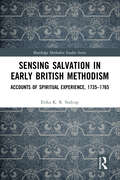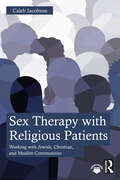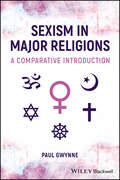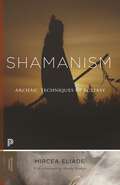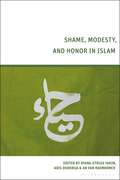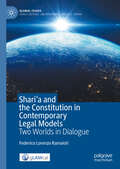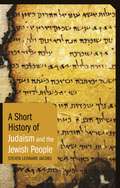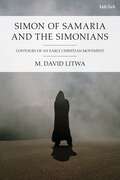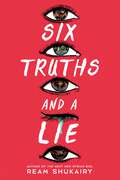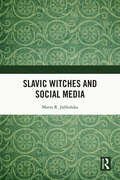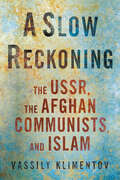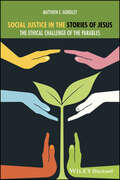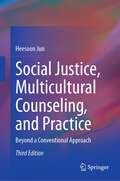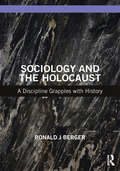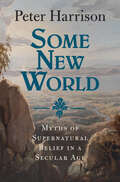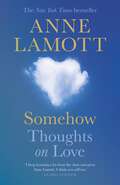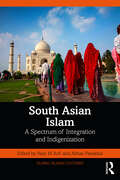- Table View
- List View
Sensing Salvation in Early British Methodism: Accounts of Spiritual Experience, 1735-1765 (Routledge Methodist Studies Series)
by Erika K.R. StalcupThis book examines the spiritual experiences of the first British Methodist lay people and the language used to describe those experiences. It reflects on physical manifestations such as shouting, weeping, groaning, visions, and out-of-body experiences and their role in the process of spiritual development. These experiences offer an intimate perspective on the surprisingly holistic origins of the evangelical revival. The study features autobiographical narratives and other first-hand manuscripts in which “ordinary” lay people recount their first impressions of Methodism, their conflicted feelings throughout the conversion process, their approach toward death and dying, and their mixed attitudes toward the task of writing itself. The book will be relevant to scholars of Methodism, evangelicalism and religious history as well as those interested in emotions and religious experience.
Sensing Salvation in Early British Methodism: Accounts of Spiritual Experience, 1735-1765 (Routledge Methodist Studies Series)
by Erika K.R. StalcupThis book examines the spiritual experiences of the first British Methodist lay people and the language used to describe those experiences. It reflects on physical manifestations such as shouting, weeping, groaning, visions, and out-of-body experiences and their role in the process of spiritual development. These experiences offer an intimate perspective on the surprisingly holistic origins of the evangelical revival. The study features autobiographical narratives and other first-hand manuscripts in which “ordinary” lay people recount their first impressions of Methodism, their conflicted feelings throughout the conversion process, their approach toward death and dying, and their mixed attitudes toward the task of writing itself. The book will be relevant to scholars of Methodism, evangelicalism and religious history as well as those interested in emotions and religious experience.
Sex Therapy with Religious Patients: Working with Jewish, Christian, and Muslim Communities
by Caleb JacobsonSex Therapy with Religious Patients is a comprehensive guidebook for mental health professionals who work with those struggling with sexual issues within a religious context. The book provides practical guidance on how to approach sensitive topics related to sex and religion, including addressing religious beliefs and values that may impact sexual behavior, beliefs, and attitudes.Drawing on research and clinical experience, the book offers a range of evidence-based interventions for working with individuals from different Jewish, Christian, and Muslim backgrounds. It also explores the unique challenges and opportunities presented by patients’ religious beliefs and provides strategies for integrating spirituality into the therapeutic process.The book is written in an accessible and engaging style, with real-life case examples and exercises that can be used in therapy sessions. It is an essential resource for mental health professionals seeking to enhance their skills in working with religious individuals who are seeking sex therapy.
Sex Therapy with Religious Patients: Working with Jewish, Christian, and Muslim Communities
by Caleb JacobsonSex Therapy with Religious Patients is a comprehensive guidebook for mental health professionals who work with those struggling with sexual issues within a religious context. The book provides practical guidance on how to approach sensitive topics related to sex and religion, including addressing religious beliefs and values that may impact sexual behavior, beliefs, and attitudes.Drawing on research and clinical experience, the book offers a range of evidence-based interventions for working with individuals from different Jewish, Christian, and Muslim backgrounds. It also explores the unique challenges and opportunities presented by patients’ religious beliefs and provides strategies for integrating spirituality into the therapeutic process.The book is written in an accessible and engaging style, with real-life case examples and exercises that can be used in therapy sessions. It is an essential resource for mental health professionals seeking to enhance their skills in working with religious individuals who are seeking sex therapy.
Sexism in Major Religions: A Comparative Introduction
by Paul GwynneA groundbreaking cross-sectional study of the forms and extent of gender inequality in the "Big Five" religions of the world Sexism in Major Religions: A Comparative Introduction provides clear and accessible analyses of the complex forms of androcentrism and patriarchy in five of the world’s major religions—Hinduism, Buddhism, Judaism, Christianity, and Islam. With a unique comparative-thematic methodology, this student-friendly textbook bridges the gap between Religious Studies and courses in Gender and Sexuality Studies, Feminist Studies, Religion and Society, and more. Following a brief introduction to each religious system covered, Sexism in Major Religions defines important terms and concepts in modern religious feminism, including sex and gender, androcentrism and patriarchy, and revolutionary and reform feminisms. Each remaining chapter focuses on one of seven themes representing the main sources and manifestations of religious discrimination against women, such as the gender of the deity, the duties of the mother, and the status of the wife within marriage. Throughout the text, author Paul Gwynne discusses the formal gender-biased teachings and practices, distinctive features, intersecting areas, and core arguments of conservative defenders and feminist critics of each religion. Provides students with deep comparative insight into the similarities and differences between major religions on issues of gender equality Offers a fresh and original approach to exploring the forms of sexism across seven distinct themes Presents a timely and accurate account of the "landscape of sexism" in five of the world's largest religions Includes a dedicated chapter examining the status of intersex and transgender persons in religious systemsDesigned to broaden students' understanding of religions through systematic and impartial discussion, Sexism in Major Religions: A Comparative Introduction is an ideal textbook for undergraduate courses in Religious Studies and Social Sciences programs, as well as an invaluable resource for general readers interested in understanding and reforming sexist features within religious traditions.
Sexism in Major Religions: A Comparative Introduction
by Paul GwynneA groundbreaking cross-sectional study of the forms and extent of gender inequality in the "Big Five" religions of the world Sexism in Major Religions: A Comparative Introduction provides clear and accessible analyses of the complex forms of androcentrism and patriarchy in five of the world’s major religions—Hinduism, Buddhism, Judaism, Christianity, and Islam. With a unique comparative-thematic methodology, this student-friendly textbook bridges the gap between Religious Studies and courses in Gender and Sexuality Studies, Feminist Studies, Religion and Society, and more. Following a brief introduction to each religious system covered, Sexism in Major Religions defines important terms and concepts in modern religious feminism, including sex and gender, androcentrism and patriarchy, and revolutionary and reform feminisms. Each remaining chapter focuses on one of seven themes representing the main sources and manifestations of religious discrimination against women, such as the gender of the deity, the duties of the mother, and the status of the wife within marriage. Throughout the text, author Paul Gwynne discusses the formal gender-biased teachings and practices, distinctive features, intersecting areas, and core arguments of conservative defenders and feminist critics of each religion. Provides students with deep comparative insight into the similarities and differences between major religions on issues of gender equality Offers a fresh and original approach to exploring the forms of sexism across seven distinct themes Presents a timely and accurate account of the "landscape of sexism" in five of the world's largest religions Includes a dedicated chapter examining the status of intersex and transgender persons in religious systemsDesigned to broaden students' understanding of religions through systematic and impartial discussion, Sexism in Major Religions: A Comparative Introduction is an ideal textbook for undergraduate courses in Religious Studies and Social Sciences programs, as well as an invaluable resource for general readers interested in understanding and reforming sexist features within religious traditions.
Shamanism: Archaic Techniques of Ecstasy
by Mircea EliadeThe foundational work on shamanism now available as a Princeton Classics paperbackShamanism is an essential work on the study of this mysterious and fascinating phenomenon. The founder of the modern study of the history of religion, Mircea Eliade surveys the tradition through two and a half millennia of human history, moving from the shamanic traditions of Siberia and Central Asia—where shamanism was first observed—to North and South America, Indonesia, Tibet, China, and beyond. In this authoritative survey, Eliade illuminates the magico-religious life of societies that give primacy of place to the figure of the shaman—at once magician and medicine man, healer and miracle-doer, priest, mystic, and poet. Synthesizing the approaches of psychology, sociology, and ethnology, Shamanism remains the reference book of choice for those interested in this practice.
Shamanism: Archaic Techniques of Ecstasy
by Mircea EliadeThe foundational work on shamanism now available as a Princeton Classics paperbackShamanism is an essential work on the study of this mysterious and fascinating phenomenon. The founder of the modern study of the history of religion, Mircea Eliade surveys the tradition through two and a half millennia of human history, moving from the shamanic traditions of Siberia and Central Asia—where shamanism was first observed—to North and South America, Indonesia, Tibet, China, and beyond. In this authoritative survey, Eliade illuminates the magico-religious life of societies that give primacy of place to the figure of the shaman—at once magician and medicine man, healer and miracle-doer, priest, mystic, and poet. Synthesizing the approaches of psychology, sociology, and ethnology, Shamanism remains the reference book of choice for those interested in this practice.
Shame, Modesty, and Honor in Islam
by Ayang Utriza Yakin, Adis Duderija and An Van RaemdonckWith a particular emphasis on definitions, continuities, and change, this edited volume examines the historical role and function of haya' – or feelings of shame, modesty, and honor – in Islamic theology and law, and explores contemporary Muslims' engagements with the concept. The book explores various conceptions of haya' and the practices associated with the concept in both Muslim majority and minority contexts. The empirically rich contributions reveal how haya' is socially constructed in varying social and cultural environments across the globe. From medieval Islam to the modern day, this book demonstrates the importance of haya' and its temporal and spatial transformations.
Shari'a and the Constitution in Contemporary Legal Models: Two Worlds in Dialogue (Global Issues)
by Federico Lorenzo RamaioliThis comparative law book aims at formulating a new analytical approach to constitutional comparisons, assuming as a starting point the different legal perspectives implied in the (Sunni) Islamic outlook on the juridical phenomena and the Western concept of law, with particular reference to constitutionalism. The volume adopts a wider and comprehensive viewpoint, comparing the different ways in which the Islamic sharīʿa and Western legal categories interact, regardless of substantive contents of specific provisions, thus avoiding conceptual biases that can sometime affect present literature on the matter. The book explores the various dynamics subtended to the interactions between sharīʿa and Western constitutionalism, providing a new classification to the different contemporary models. The philosophical and legal comparisons are analyzed in a dynamic way, based on a wide range of contemporary constitutional systems, virtually encompassing all the States in which Sunni Islam plays a major cultural role, and taking also into consideration non-State actors and non-recognized actors."Published in cooperation with gLAWcal - Global Law Initiatives for Sustainable Development, Hornchurch, Essex, United Kingdom".
A Short History of Judaism and the Jewish People (Short Histories)
by Steven Leonard JacobsIn this exciting addition to Bloomsbury's Short Histories series, Steven Leonard Jacobs critically yet concisely examines the history of Judaism and the Jewish people, drawing from maps, photographs and archives to illuminate the history of one of the world's oldest religions.Beginning by establishing a definition of Judaism, Jacobs explores the historiography of the Jewish people, in addition to the role of memory in charting history. Including a comprehensive breakdown of the history of Judaism, the author splits discussion into defined eras, taking readers from the beginnings of Judaism, to the split between Judah in the South and Israel in the North, the united Monarchy, and the Age of the Prophets. Exploring the social structures and institutions of ancient Israel, Jacobs incorporates key themes such as civic life, economics, and art – before analysing the interactions of Judaism with Romanism and Hellenism. Moving through the Middle Ages and Pre-Modernity, and acknowledging the role of key figures such as Yosef Karo and Moses Mendelssohn, this book brings the narrative up to the present day, and uncovers the foundations of Judaism in modernity.Jacobs' authoritative yet engaging prose shines through each of the thirteen chapters, which seamlessly intertwine to produce a thorough yet concise examination of the history of Judaism and Jewish peoples.
Simon of Samaria and the Simonians: Contours of an Early Christian Movement
by Dr M. David LitwaWho were the Simonians? Beginning in the mid-second century CE, heresiologists depicted them as licentious followers of the first “gnostic,” a supposedly Samarian self-deifier called Simon, who was thought to practice “magic” and became known as the father of all heresies.Litwa examines the Simonians in their own literature and in the literature used to refute and describe them. He begins with Simonian primary sources, namely The Declaration of Great Power (embedded in the anonymous Refutation of All Heresies) and The Concept of Our Great Power (Nag Hammadi codex VI,4). Litwa argues that both are early second-century products of Simonian authors writing in Alexandria or Egypt. Litwa then moves on to examine the heresiological sources related to the Simonians (Justin, the book of Acts, Irenaeus, the author of the Refutation of All Heresies, Pseudo-Tertullian, Epiphanius, and Filaster). He shows how closely connected Justin's report is to the portrait of Simon in Acts, and offers an extensive exegesis and analysis of Simonian theology and practice based on the reports of Irenaeus and the Refutator. Finally, Litwa examines Simonianism in novelistic sources, namely the Acts of Peter and the Pseudo-Clementines. By the time these sources were written, Simon had become the father of all heresies. Accordingly, virtually any heresy could be attributed to Simon. As a result-despite their alluring portraits of Simon-these sources are mostly unusable for the historical study of the Simonian Christian movement. Litwa concludes with a historical profile of the Simonian movement in the second and third centuries.The book features appendices which contain Litwa's own translations of primary Simonian texts.
Six Truths and a Lie
by Ream ShukairySix Muslim teens are falsely accused of a deadly attack in this timely and harrowing examination of America&’s justice system, perfect for fans of Angie Thomas and Samira Ahmed. As fireworks pop off at a rowdy Fourth of July bonfire party, an explosion off the California coast levels an oil rig—resulting in chaos and worse, murder. At the center are six Muslim teens - six patriots, six strangers, and six suspects. An old soul caught in the wrong place. An aspiring doctor. An influencer with a reputation to protect. A perfect daughter with secrets to hide. A soccer star headed for Stanford. An immigrant in love. Each with something to hide and everything to lose. Faced with accusations of terrorism, The Six are caught in a political game that will pit them against each other in exchange for exoneration. They must choose: frame each other to guarantee their own independence or expose their secrets to earn back freedom for them all.
Slavic Witches and Social Media
by Marta R. JabłońskaSlavic Witches and Social Media examines the role of social media in the spiritual practices of modern Slavic witches and draws a comparative analysis between contemporary neopaganism and Catholicism in Poland. This volume presents a fresh and comprehensive examination of Slavic witches within the context of the growing popularity of neopagan religions and the integration of social media in religious practices. It delves into contemporary witchcraft in Poland, including the prominent Wicca tradition, native Slavic beliefs with their diverse pantheon of deities, extensive demonology, and profound respect for nature, as well as individual, eclectic paths. Through a digital religion study, this book investigates how neopagans and Catholics incorporate social media into their spiritual journeys. Its vivid portrait of a Slavic witch provides a deeper understanding of their beliefs, practices, and engagement with social media platforms. This book is dedicated to scholars in the field of religious sociology, digital religion, and ethnography with a deep fascination for exploring folk magic and Slavic traditions and their adaptation to the emerging digital landscape. It is an insightful resource for researchers in theology, communication, and new media, as well as for all researchers and individuals who share an interest in the captivating realm of contemporary witches and witchcraft.
Slavic Witches and Social Media
by Marta R. JabłońskaSlavic Witches and Social Media examines the role of social media in the spiritual practices of modern Slavic witches and draws a comparative analysis between contemporary neopaganism and Catholicism in Poland. This volume presents a fresh and comprehensive examination of Slavic witches within the context of the growing popularity of neopagan religions and the integration of social media in religious practices. It delves into contemporary witchcraft in Poland, including the prominent Wicca tradition, native Slavic beliefs with their diverse pantheon of deities, extensive demonology, and profound respect for nature, as well as individual, eclectic paths. Through a digital religion study, this book investigates how neopagans and Catholics incorporate social media into their spiritual journeys. Its vivid portrait of a Slavic witch provides a deeper understanding of their beliefs, practices, and engagement with social media platforms. This book is dedicated to scholars in the field of religious sociology, digital religion, and ethnography with a deep fascination for exploring folk magic and Slavic traditions and their adaptation to the emerging digital landscape. It is an insightful resource for researchers in theology, communication, and new media, as well as for all researchers and individuals who share an interest in the captivating realm of contemporary witches and witchcraft.
A Slow Reckoning: The USSR, the Afghan Communists, and Islam (NIU Series in Slavic, East European, and Eurasian Studies)
by Vassily KlimentovA Slow Reckoning examines the Soviet Union's and the Afghan communists' views of and policies toward Islam and Islamism during the Soviet-Afghan War (1979–1989). As Vassily Klimentov demonstrates, the Soviet and communist Afghan disregard for Islam was telling of the overall communist approach to reforming Afghanistan and helps explain the failure of their modernization project.A Slow Reckoning reveals how during most of the conflict Babrak Karmal, the ruler installed by the Soviets, instrumentalized Islam in support of his rule while retaining a Marxist-Leninist platform. Similarly, the Soviets at all levels failed to give Islam its due importance as communist ideology and military considerations dominated their decision making. This approach to Islam only changed after Mikhail Gorbachev replaced Karmal by Mohammad Najibullah and prepared to withdraw Soviet forces. Discarding Marxism-Leninism for Islam proved the correct approach, but it came too late to salvage the Soviet nation-building project. A Slow Reckoning also shows how Soviet leaders only started seriously paying attention to an Islamist threat from Afghanistan to Central Asia after 1986. While the Soviets had concerns related to Islamism in 1979, only the KGB believed the threat to be potent. The Soviet elites never fully conceptualized Islamism, continuing to see it as an ideology the United States, Iran, or Pakistan could instrumentalize at will. They believed the Islamists had little agency and that their retrograde ideology could not find massive appeal among progressive Soviet Muslims. In this, they were only partly right.
Social Justice in the Stories of Jesus: The Ethical Challenge of the Parables (Lived Religions)
by Matthew E. GordleyInvites a new generation of readers to apply ethical reasoning to social justice challenges, accessible to people of faith from a broad range of backgrounds Social Justice in the Stories of Jesus introduces readers to the parables of the New Testament while exploring how they relate to social justice, ethics, and key issues of modern society. Centering on themes of mercy, justice, and human dignity, this unique volume invites readers to reflect on the meaning of Jesus's parables both in their original setting and in the context of present-day moral and ethical challenges. The author discusses social justice concepts from various traditions to enable readers to engage with the ethical implications of the parables in a range of different contexts. Each chapter focuses on one parable or set of parables, such as the parable of the Good Samaritan and the parable of the Pharisee and the Tax Collector, and includes historical background information and an analysis and interpretation of the parable. Throughout the text, the author highlights the connections between Jesus's parables and racism, violence, poverty, the environment, our obligations to one another, and other timely social justice issues. Blends an accessible overview of the parables of Jesus with an introduction to social justice and ethics Explores New Testament parables as viewed through the lens of contemporary writers, ethicists, and activists Emphasizes the Jewish roots of the parables and the need to guard against anti-Jewish readings of the parables Highlights the ways that Jesus’s parables challenged his first-century listeners to see their world in new ways and recognize the dignity of every person Engages with seminal thinkers in contemporary social justice, such as James Cone, Howard Thurman, Emilie Townes, Bishop Michael Curry, and Pope Francis Includes study and discussion questions for personal and group use Requiring no prior knowledge of the subject, Social Justice in the Stories of Jesus: The Ethical Challenge of the Parables is an ideal textbook for introductory courses on the Bible and New Testament, faith-based courses on ethics, and general Christian readers looking for an excellent resource for personal or congregational study.
Social Justice in the Stories of Jesus: The Ethical Challenge of the Parables (Lived Religions)
by Matthew E. GordleyInvites a new generation of readers to apply ethical reasoning to social justice challenges, accessible to people of faith from a broad range of backgrounds Social Justice in the Stories of Jesus introduces readers to the parables of the New Testament while exploring how they relate to social justice, ethics, and key issues of modern society. Centering on themes of mercy, justice, and human dignity, this unique volume invites readers to reflect on the meaning of Jesus's parables both in their original setting and in the context of present-day moral and ethical challenges. The author discusses social justice concepts from various traditions to enable readers to engage with the ethical implications of the parables in a range of different contexts. Each chapter focuses on one parable or set of parables, such as the parable of the Good Samaritan and the parable of the Pharisee and the Tax Collector, and includes historical background information and an analysis and interpretation of the parable. Throughout the text, the author highlights the connections between Jesus's parables and racism, violence, poverty, the environment, our obligations to one another, and other timely social justice issues. Blends an accessible overview of the parables of Jesus with an introduction to social justice and ethics Explores New Testament parables as viewed through the lens of contemporary writers, ethicists, and activists Emphasizes the Jewish roots of the parables and the need to guard against anti-Jewish readings of the parables Highlights the ways that Jesus’s parables challenged his first-century listeners to see their world in new ways and recognize the dignity of every person Engages with seminal thinkers in contemporary social justice, such as James Cone, Howard Thurman, Emilie Townes, Bishop Michael Curry, and Pope Francis Includes study and discussion questions for personal and group use Requiring no prior knowledge of the subject, Social Justice in the Stories of Jesus: The Ethical Challenge of the Parables is an ideal textbook for introductory courses on the Bible and New Testament, faith-based courses on ethics, and general Christian readers looking for an excellent resource for personal or congregational study.
Social Justice, Multicultural Counseling, and Practice: Beyond a Conventional Approach
by Heesoon JunThis third edition book offers a paradigm shift in thinking (from binary to complex) and enables visibility for the intersectionality of multiple identities that range from privileged to oppressed. For example, real people’s heterogeneous racial identities within the same racial group are visible. A paradigm shift in learning (from conceptual to transformative) connects conceptual learning (cognition) to their experience (affect). “…. transformation does not simply emerge due to the individual’s awareness…. but is experienced” (Benetka & Joerchel, 2016, p. 22). Uncensored first-person (subjective) written responses to specific questions to access unconscious and implicit bias will connect the writer’s experience to conceptual learning of diversity, equity, and inclusion. Writing in third person (objective) interrupts the transformative aspect by bypassing the accessibility of inner experience. Writing in first-person connects the writer to their experience which allows the unconscious to be accessed if it is practiced on a regular basis. This book is for everyone who wants to implement diversity, equity, and inclusion measures by learning to access their unconscious bias. Understanding social justice and equity and good intentions alone do not lead to accessing unconscious bias.
Sociology and the Holocaust: A Discipline Grapples with History
by Ronald J BergerFor some time the conventional wisdom in the interdisciplinary field of Holocaust studies is that sociologists have neglected this subject matter, but this is not really the case. In fact, there has been substantial sociological work on the Holocaust, although this scholarship has often been ignored or neglected including in the discipline of sociology itself. Sociology and the Holocaust brings this scholarly tradition to light, and in doing so offers a comprehensive synthesis of the vast historical and social science literature on the before, during, and after of the Holocaust—a tour d’horizon from an explicitly sociological perspective. As such, the aim of the book is not simply to describe the chronology of events that culminated in the deaths of 6 million Jews but to draw upon sociology’s “theoretical toolkit” to understand these events and the ongoing legacy of the Holocaust sociologically.
Sociology and the Holocaust: A Discipline Grapples with History
by Ronald J BergerFor some time the conventional wisdom in the interdisciplinary field of Holocaust studies is that sociologists have neglected this subject matter, but this is not really the case. In fact, there has been substantial sociological work on the Holocaust, although this scholarship has often been ignored or neglected including in the discipline of sociology itself. Sociology and the Holocaust brings this scholarly tradition to light, and in doing so offers a comprehensive synthesis of the vast historical and social science literature on the before, during, and after of the Holocaust—a tour d’horizon from an explicitly sociological perspective. As such, the aim of the book is not simply to describe the chronology of events that culminated in the deaths of 6 million Jews but to draw upon sociology’s “theoretical toolkit” to understand these events and the ongoing legacy of the Holocaust sociologically.
Some New World: Myths of Supernatural Belief in a Secular Age
by null Peter HarrisonIn his famous argument against miracles, David Hume gets to the heart of the modern problem of supernatural belief. 'We are apt', says Hume, 'to imagine ourselves transported into some new world; where the whole form of nature is disjointed, and every element performs its operation in a different manner, from what it does at present.' This encapsulates, observes Peter Harrison, the disjuncture between contemporary Western culture and medieval societies. In the Middle Ages, people saw the hand of God at work everywhere. Indeed, many suppose that 'belief in the supernatural' is likewise fundamental nowadays to religious commitment. But dichotomising between 'naturalism' and 'supernaturalism' is actually a relatively recent phenomenon, just as the notion of 'belief' emerged historically late. In this masterful contribution to intellectual history, the author overturns crucial misconceptions – 'myths' – about secular modernity, challenging common misunderstandings of the past even as he reinvigorates religious thinking in the present.
Somehow: Thoughts on Love
by Anne LamottLove is our only hope. It is not always the easiest choice, but it is always the right one, the noble path, the way home to safety, no matter how bleak the future looks. In Somehow: Thoughts on Love, Anne Lamott explores the transformative power that love has in our lives: how it surprises us, forces us to confront uncomfortable truths, reminds us of our humanity and guides us forward. In each chapter, Lamott refracts all the colours of the spectrum. She explores the unexpected love for a partner later in life. The bruised (and bruising) love for a child who disappoints, even frightens. Drawing from her own life and experience to delineate the intimate and elemental ways that love buttresses us in the face of despair, she galvanises us to believe that tomorrow will be better than today. The lessons she underscores are that love enlightens as it educates, comforts as it energises, sustains as it surprises. Full of the compassion and humanity that have made Lamott beloved by millions of readers, Somehow is classic Anne Lamott: funny, warm and wise.
South Asian Islam: A Spectrum of Integration and Indigenization (Global Islamic Cultures)
by Nasr M Arif Abbas PanakkalThis volume explores the historical trajectory of the spread of Islam in South Asia and how the engagements of the past have played a crucial role in the making of the present outfits of South Asian Islam. Islam in South Asia has maintained a distinct role while imbibing cultural, social, ethnic, folk, and artistic networks of the subcontinent in diverse echelons. In an unequivocal analysis, this volume showcases the visible varieties of Islam from an array of regional cultural, ethnic, and vernacular groups. While many characteristics remain distinct in different provinces or regions of South Asia, similarities are palpable in etiquettes, customary laws, art, and architecture. More than regional differences, various ethnic groups from all poles of the Indian subcontinent have paved the way for the dissimilar landscapes of Islam, in tandem with differences in language, culture, and festivals. The case studies in this book exhibit forms of cultural pluralism in the communities, which have helped in building a cohesive community. Part of the ‘Global Islamic Cultures’ series that looks at integrated and indigenized Islam, this book will be of interest to students and researchers of religion, religious history, theology, study of Islamic law and politics, cultural studies, and South Asian Studies. It will also be useful to general readers who are interested in world religions and cultures.
South Asian Islam: A Spectrum of Integration and Indigenization (Global Islamic Cultures)
This volume explores the historical trajectory of the spread of Islam in South Asia and how the engagements of the past have played a crucial role in the making of the present outfits of South Asian Islam. Islam in South Asia has maintained a distinct role while imbibing cultural, social, ethnic, folk, and artistic networks of the subcontinent in diverse echelons. In an unequivocal analysis, this volume showcases the visible varieties of Islam from an array of regional cultural, ethnic, and vernacular groups. While many characteristics remain distinct in different provinces or regions of South Asia, similarities are palpable in etiquettes, customary laws, art, and architecture. More than regional differences, various ethnic groups from all poles of the Indian subcontinent have paved the way for the dissimilar landscapes of Islam, in tandem with differences in language, culture, and festivals. The case studies in this book exhibit forms of cultural pluralism in the communities, which have helped in building a cohesive community. Part of the ‘Global Islamic Cultures’ series that looks at integrated and indigenized Islam, this book will be of interest to students and researchers of religion, religious history, theology, study of Islamic law and politics, cultural studies, and South Asian Studies. It will also be useful to general readers who are interested in world religions and cultures.
